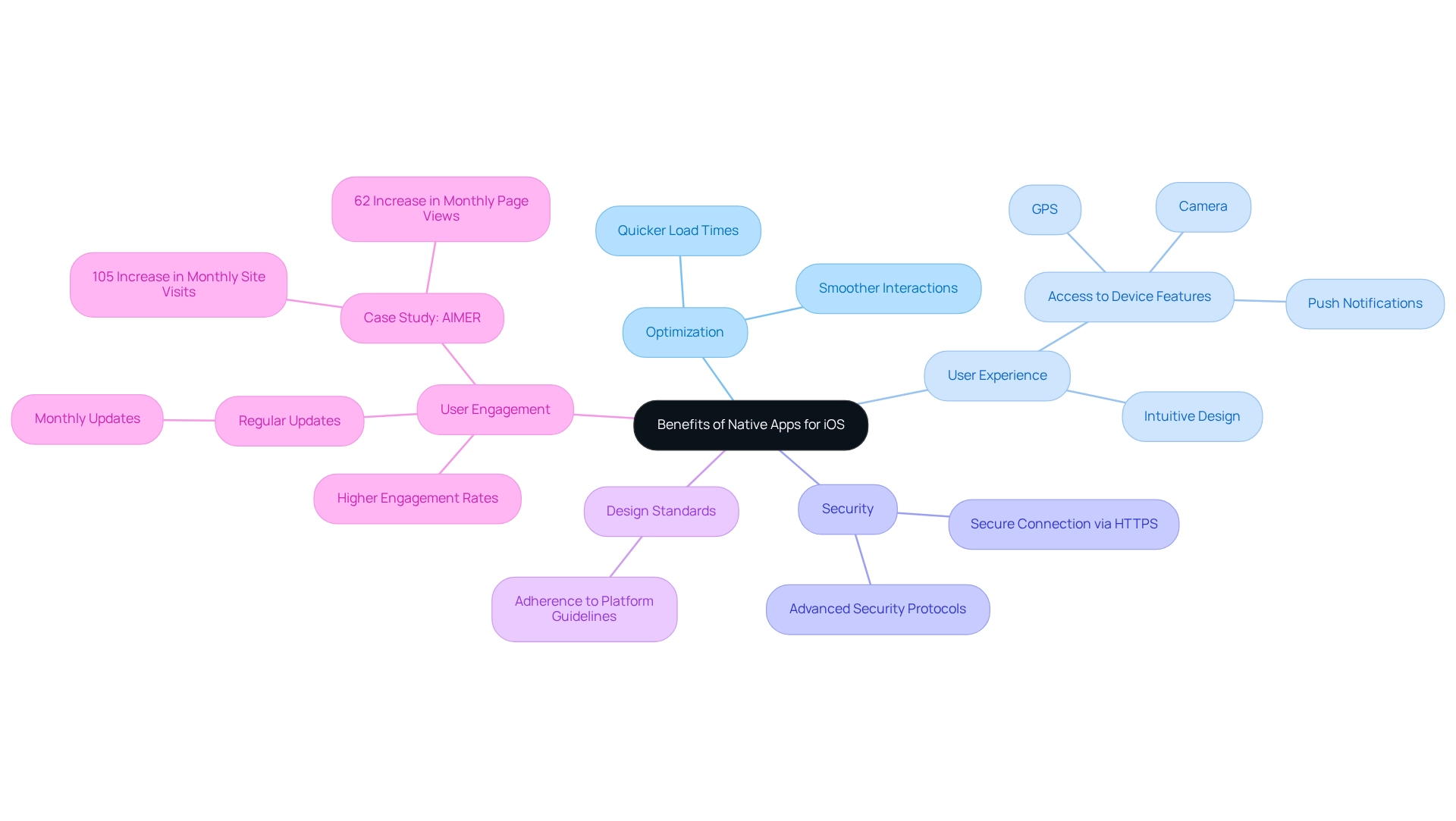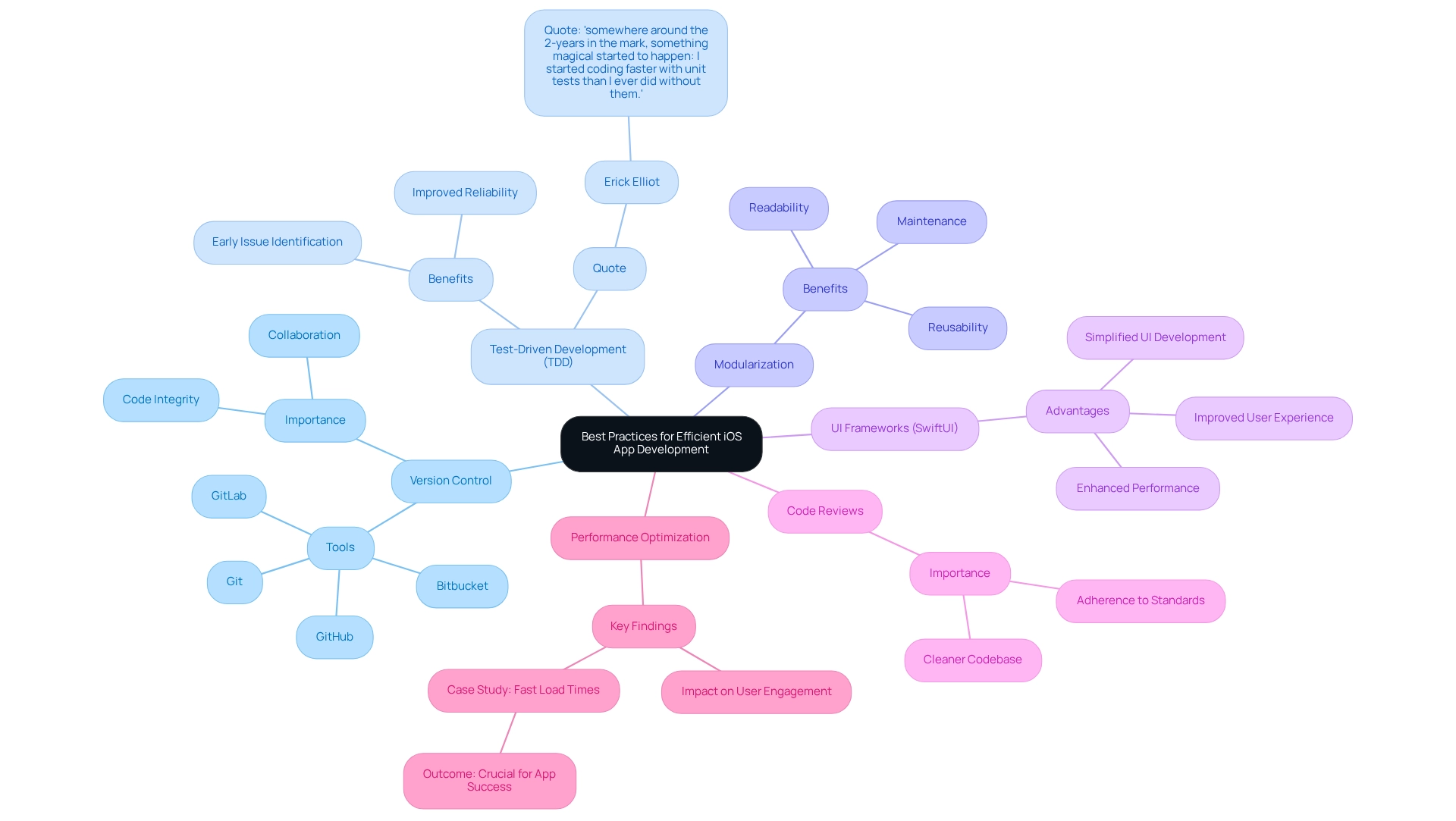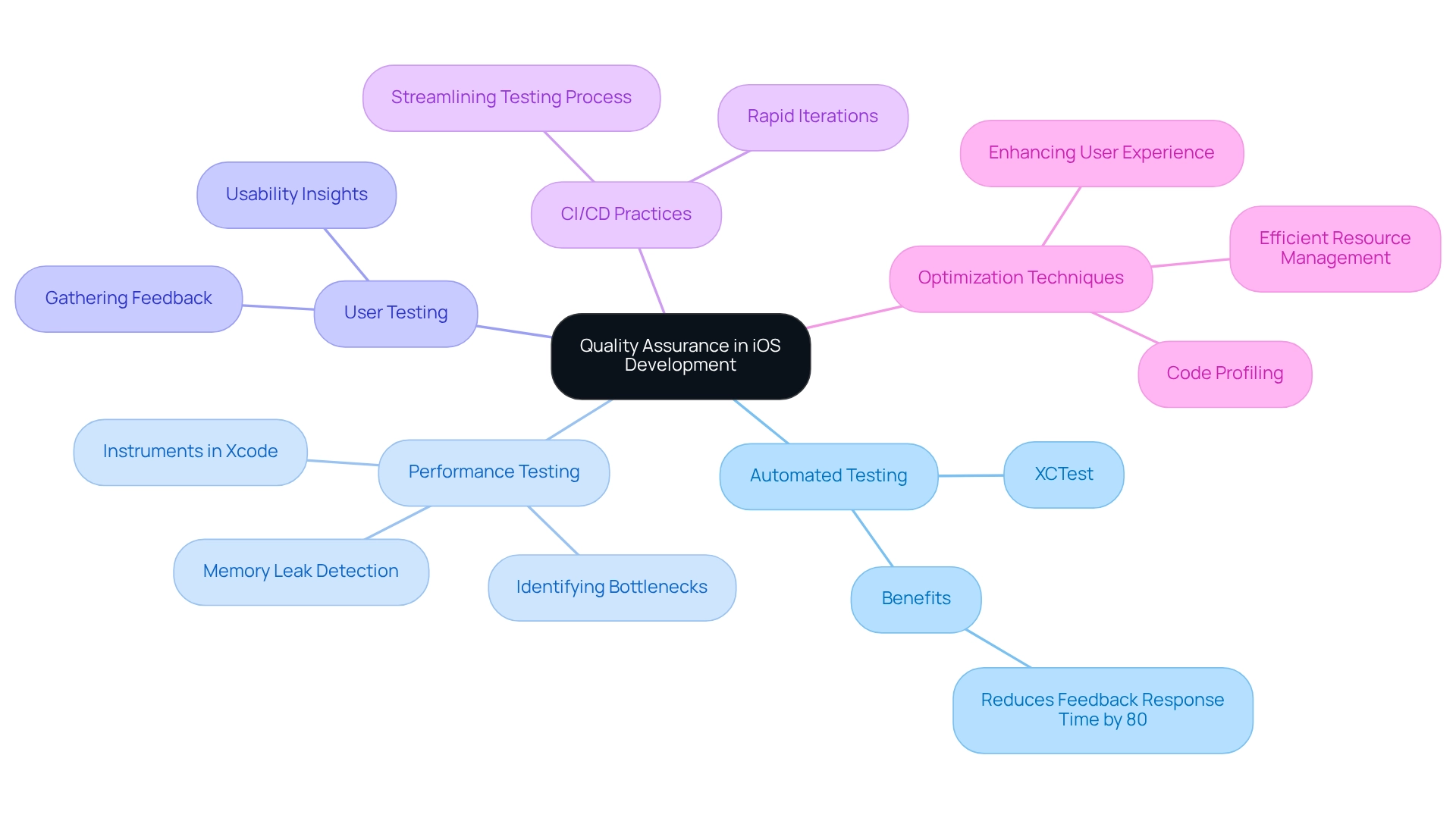Overview
Mastering native app iOS development can be quite challenging for developers. It involves grasping essential fundamentals like the MVC architecture, utilizing Swift or Objective-C, and adhering to Apple's Human Interface Guidelines to create high-quality applications. However, how do developers overcome these hurdles? This is where Kodezi comes into play, offering tools designed to streamline the development process.
Kodezi addresses these coding challenges with features that enhance efficiency and productivity. By integrating best practices such as Test-Driven Development and continuous integration, it significantly boosts app performance and user engagement. Imagine being able to focus more on creativity and less on repetitive tasks—this is the promise of Kodezi.
The benefits of using Kodezi are clear: improved productivity, better code quality, and a more enjoyable development experience. Why struggle with the complexities of iOS development alone when you can leverage these powerful tools?
Explore the range of tools available on the Kodezi platform and take your iOS development skills to the next level. With Kodezi, mastering app development becomes not just a goal but an achievable reality.
Introduction
In the rapidly evolving world of mobile technology, developers often face significant challenges in creating high-performance, user-friendly applications. How can they overcome these hurdles? Enter Kodezi, a platform designed to streamline the development process and enhance productivity. By mastering the fundamentals of native iOS application development, including the essential Model-View-Controller (MVC) architecture, developers can ensure maintainability and scalability. Kodezi addresses these challenges with features that promote best practices like Test-Driven Development and effective version control.
Furthermore, the significance of rigorous testing and optimization cannot be overstated. These practices are key to delivering quality applications that resonate with users. With Kodezi, developers can leverage tools that simplify testing and improve code quality, ultimately leading to successful application launches. Imagine the impact of using a platform that not only enhances efficiency but also fosters sustained user engagement. This article delves into the core principles of native app development, highlighting strategies that can guide developers toward achieving their goals.
Understand Native App Development Fundamentals
The development of native app iOS is pivotal for creating applications specifically designed for the iOS platform. A solid grasp of core components, particularly the Model-View-Controller (MVC) architecture, is essential for developers. MVC promotes a clear separation of concerns, which enhances both code maintainability and scalability. Additionally, familiarity with interface design principles is vital, as it directly impacts user experience. Developers should utilize Swift or Objective-C, the primary programming languages for iOS, and become proficient in Xcode, Apple's integrated development environment (IDE), which offers extensive tools for coding, debugging, and testing.
Furthermore, adhering to Apple's Human Interface Guidelines is crucial for ensuring applications are intuitive and user-friendly. As of 2025, the importance of MVC architecture in iOS development is underscored by its role in improving app performance and user engagement. Recent statistics reveal that the native app iOS continues to dominate the market, with a significant number of mobile users preferring it for its speed and responsiveness. The global mobile payment market is projected to grow from $2.98 trillion in 2023 to $18.84 trillion by 2030, reflecting the rising adoption of mobile solutions and the essential role of native app iOS in this expansion.
David William Jenkin, a content writer, emphasizes that "success now relies as much on post-launch strategy (ASO, engagement, security) as on the creation itself," highlighting the importance of ongoing engagement and security in the success of native apps. Moreover, the choice between native app iOS and hybrid app development can significantly affect revenue generation, as native app iOS options offer superior performance and user engagement. This foundational knowledge not only prepares developers for advanced practices but also aligns with current trends in native app development, paving the way for successful application launches. A case study on effective iOS app development using MVC architecture further exemplifies the efficacy of this approach in real-world applications.
Leverage the Benefits of Native Apps for iOS
Native apps offer distinct advantages over hybrid alternatives, primarily due to their optimization for specific hardware and software configurations. This optimization leads to quicker load times and smoother interactions, significantly enhancing user experience. Furthermore, native applications have direct access to essential device features like the camera, GPS, and push notifications, which not only boost functionality but also increase user engagement.
Security stands out as another crucial advantage; native apps can implement advanced security protocols that are often more challenging to establish in hybrid applications. As Heady points out, 'In order to be classified as a PWA, the implementation must leverage a secure connection via HTTPS,' underscoring the importance of security in app development. This capability is vital in an era where data protection is a top priority for users.
Moreover, native applications provide a smooth and intuitive experience by adhering closely to the design standards and guidelines of their respective platforms. Statistics reveal that engagement with native apps is significantly higher, with many successful applications being updated at least once a month to sustain performance and relevance. This regular updating is essential for maintaining user engagement and ensuring the app remains competitive.
For instance, AIMER, a lingerie brand that transitioned to a more powerful platform, experienced a 105% increase in monthly site visits, illustrating how effectively optimized native applications can enhance engagement and performance. By leveraging device features effectively, successful native app iOS not only enhance performance but also foster greater customer loyalty and satisfaction. Furthermore, a robust discovery process is critical in identifying the optimal mobile app strategy, ensuring that development aligns with user needs and market demands.

Implement Best Practices for Efficient iOS App Development
In the fast-paced world of iOS app development, developers often face numerous coding challenges when working on a native app iOS. To navigate these obstacles effectively, embracing best practices is crucial. Tools like Kodezi stand out as significant enhancers of productivity, providing solutions tailored to modern development needs.
Utilizing version control systems such as Git is essential for managing changes and fostering collaboration among team members. In 2025, nearly all new projects leverage Git, with platforms like GitHub, GitLab, and Bitbucket leading the way. This trend underscores the vital role of version control in maintaining code integrity and optimizing workflows.
Another key practice is implementing Test-Driven Development (TDD), which significantly improves software reliability. By composing tests before actual implementation, developers can identify issues early, leading to more resilient applications. As programmer and author Erick Elliot noted, "somewhere around the 2-years in the mark, something magical started to happen: I started coding faster with unit tests than I ever did without them." This statement emphasizes TDD's importance in today's development environment, where efficiency is paramount.
Moreover, modularizing software enhances readability and reusability, making maintenance and updates more manageable. Leveraging frameworks such as SwiftUI can further simplify UI development, enhancing both performance and user experience. Furthermore, incorporating Kodezi's AI-driven functionalities streamlines error rectification and bug examination, allowing programmers to focus on advanced tasks and improve overall efficiency. Unlike rivals such as Copilot, Kodezi emphasizes autocorrecting programming rather than merely autocompleting it, ensuring developers can address issues effectively.
Regular code reviews and adherence to coding standards contribute to a cleaner, more efficient codebase. A case study on the impact of fast load times in native app iOS applications reveals that optimizing performance is crucial for audience engagement and retention. This highlights the significance of these best practices in achieving app success, as quicker load times can greatly enhance customer satisfaction.
By integrating these strategies, along with tools like Kodezi CLI for auto-healing codebases, developers can significantly boost productivity and ensure their applications meet the highest standards in 2025. Here’s a summary of the best practices:
- Utilize version control systems (Git, GitHub, GitLab, Bitbucket)
- Implement Test-Driven Development (TDD)
- Modularize code for readability and reusability
- Leverage frameworks like SwiftUI for UI development
- Conduct regular code reviews and adhere to coding standards
- Optimize load times to enhance user engagement and retention

Prioritize Testing and Optimization for Quality Assurance
Quality assurance is a critical aspect of the iOS development lifecycle, presenting a common challenge for developers. Implementing automated testing frameworks such as XCTest enables programmers to conduct thorough unit and UI testing, ensuring that each component operates as expected. Furthermore, performance testing is vital; tools like Instruments in Xcode help identify bottlenecks and memory leaks that can adversely affect app performance. User testing should also be prioritized to gather feedback on usability and functionality, providing insights that can drive further enhancements.
In addition, adopting continuous integration and deployment (CI/CD) practices streamlines the testing process, allowing for rapid iterations and improvements. In fact, automated testing can decrease programmers' feedback response time by up to 80%, highlighting its importance in upholding high-quality standards. Moreover, optimizing app performance through techniques such as code profiling and efficient resource management not only enhances functionality but also elevates the overall user experience.
As the iOS development landscape evolves, staying informed about the latest automated testing frameworks and performance testing tools becomes essential for those aspiring to deliver outstanding applications. Significantly, with over 20,000 participants in the testing tips and tricks list, there is a growing interest in effective testing methods among programmers. Additionally, insights from a case study on outsourcing trends in software development indicate that more than 50% of Fortune 500 companies are outsourcing their software projects, underscoring the necessity for robust quality assurance practices to maintain high standards in outsourced projects.
Kashyap Pujara, a seasoned project manager and IT expert, underscores the importance of integrating quality assurance into the development process for achieving success. By prioritizing testing and optimization, developers can ensure their applications meet the highest quality standards while adapting to the industry's evolving demands.

Conclusion
The landscape of mobile app development is increasingly competitive, presenting numerous coding challenges for developers. Mastering the fundamentals of native iOS development is essential for those aiming to create high-performance applications. By understanding the Model-View-Controller (MVC) architecture and adhering to Apple's Human Interface Guidelines, developers can produce applications that are not only maintainable and scalable but also user-friendly. The advantages of native apps, such as faster load times and direct access to device features, underscore the importance of this specialized approach in enhancing user engagement and satisfaction.
Furthermore, implementing best practices like version control systems and Test-Driven Development significantly boosts the efficiency and reliability of the development process. Tools like Kodezi play a crucial role in automating tasks, allowing developers to focus on innovation rather than getting bogged down by routine coding issues. Regular code reviews and performance optimization are vital for maintaining a clean codebase, ensuring that the final product meets the highest standards of quality.
In addition, prioritizing rigorous testing and optimization throughout the development lifecycle cannot be overstated. Automated testing frameworks and performance testing tools are essential for identifying issues early, leading to a more robust application that resonates with users. As the mobile technology landscape continues to evolve, staying informed and adaptable to new practices will be critical for developers striving to deliver exceptional applications.
In conclusion, by leveraging the right tools and strategies, developers can navigate the complexities of native iOS app development successfully. The combination of a solid foundation in app architecture, adherence to best practices, and a commitment to quality assurance will not only enhance productivity but also foster sustained user engagement, ultimately leading to successful application launches.
Frequently Asked Questions
Why is the development of native app iOS important?
Native app iOS development is crucial for creating applications specifically designed for the iOS platform, ensuring optimal performance and user experience.
What architecture should developers understand for iOS app development?
Developers should have a solid grasp of the Model-View-Controller (MVC) architecture, which promotes a clear separation of concerns, enhancing code maintainability and scalability.
What programming languages are primarily used for iOS development?
The primary programming languages for iOS development are Swift and Objective-C.
What integrated development environment (IDE) should developers become proficient in?
Developers should become proficient in Xcode, Apple's integrated development environment, which provides extensive tools for coding, debugging, and testing.
Why is familiarity with interface design principles important?
Familiarity with interface design principles is vital because it directly impacts user experience, making applications more intuitive and user-friendly.
What are Apple’s Human Interface Guidelines?
Apple’s Human Interface Guidelines are standards that developers should adhere to in order to ensure their applications are intuitive and user-friendly.
How does the MVC architecture affect app performance and user engagement?
The MVC architecture improves app performance and user engagement by promoting better organization of code and enhancing the overall user experience.
What is the projected growth of the global mobile payment market?
The global mobile payment market is projected to grow from $2.98 trillion in 2023 to $18.84 trillion by 2030, indicating a rising adoption of mobile solutions.
What factors contribute to the success of native apps according to David William Jenkin?
According to David William Jenkin, success relies on both post-launch strategy (such as App Store Optimization, engagement, and security) and the initial creation of the app.
How does the choice between native app iOS and hybrid app development affect revenue generation?
The choice between native app iOS and hybrid app development can significantly affect revenue generation, as native app iOS options typically offer superior performance and user engagement.




